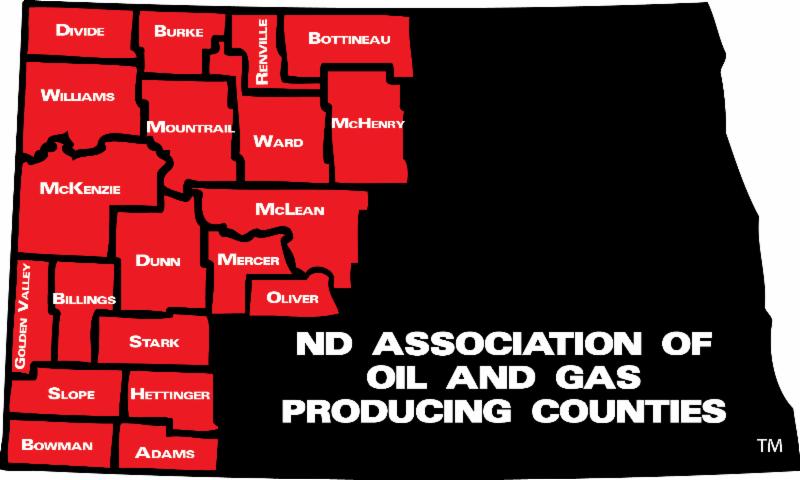
|
North Dakota Association of Oil and Gas Producing Counties
|
|
|
Stay Connected

|
Basin Bits Magazine
This semiannual magazine, published in the spring and fall, is the official publication of the ND Association of Oil and Gas Producing Counties.
To sign up to receive a copy of the magazine, please click here.
To read the latest Basin Bits edition via PDF, click this link.
|
Uniform County Truck Permit System
This is a county road permit system for over-weight or over-width vehicles on county roads. Since 1986, the NDAOGPC has operated the Uniform County Truck Permit program as a service to counties and the petroleum industry.
For more information or to get permits, click here.
|
|
 |
|
 Thank you for your continued interest in the activity of the ND Association of Oil and Gas Producing Counties Thank you for your continued interest in the activity of the ND Association of Oil and Gas Producing Counties
We hope that you will find this week's News From the NDAOGPC as a valuable source of information.
Have a great weekend!
|
|
EmPower ND Commission Discusses Legislative Objectives
|
The EmPower ND Commission faced a two-day meeting this week full of strategy decisions on how the state can make the most of its resources. At the table, oil, coal, wind, and ethanol interests discussed strategies for state policymakers to consider in the 2015 legislative session. Commission members brainstormed on how to meet current workforce challenges and housing shortages.
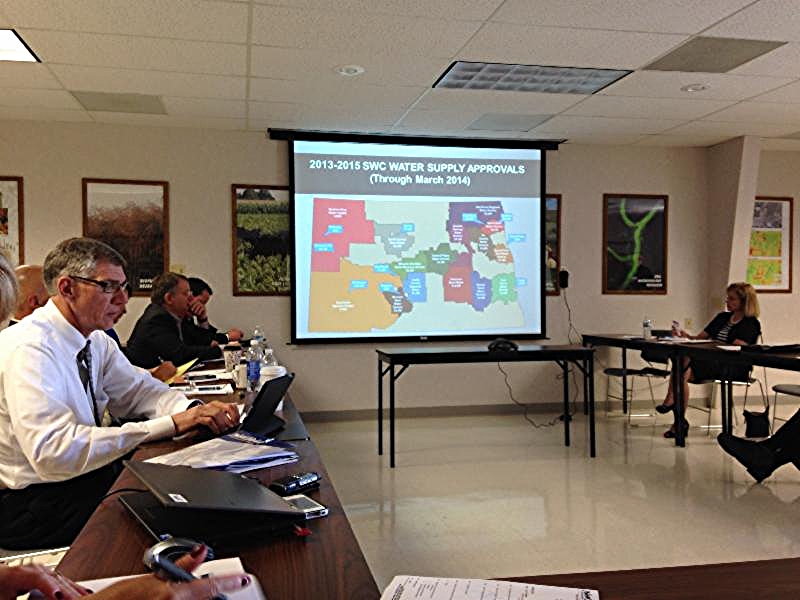 | |
Members of the EmPower ND Commission listen as Michelle Klose, Asst. State Water Engineer, responds to questions on water lawsuits brought by Canada and the state of Missouri.
|
The Commission, chaired by ND Commerce Commissioner Al Anderson, heard two major presentations on Thursday morning. The first was an update on the need for additional water for both domestic and industrial use. Assistant State Engineer Michelle Klose told the group that it wasn't but a few years ago that the state's oil tax only generated $10 million for water projects statewide. Today, it's expected to generate $700 million from the oil extraction tax. She listed NAWS, WAWS, and SWPP as three western water systems in place that will grow as the region grows. A federal court injunction is currently preventing the NAWS system from reaching Bottineau, which also needs water. The state is studying possible routes to get Missouri River water to the Red River Valley via state funding avenues. The state now consumes about 350,000 acre-feet of water; 17,000 acre-feet are used for fracking wells. "We are protecting the Fox Hills acquifer," Klose said. She added that 48% of the fracking water supply comes from ground water sources, with 20% coming from Lake Sakakawea. It was reported that Jamestown will also need additional water to grow industry there.
HIS Chemical consultants Don Bari and Ed Glatzer gave an early preview of their study on value added petrochemicals. There is now an expanding potential for chemical plants in ND by using byproducts from the Liquid Natural Gas feedstock in the Bakken. Bottom line: ND is physically closer to Rust Belt states and as feedstock supplies grow, they can challenge Gulf Coast states for their northern mid-coast customers. Resins, plastics, and rubber present lots of opportunity from the Bakken oil field. It may take a partner who already has customers and is looking to expand. On the "A" list are Exxon Mobil, Equistar, Dow, Williams, and Vinmar, to name a few. "They bring the market, so you can't underestimate that," Bari said. The study will be finished and explained at the legislative interim Energy Development and Transmission Committee meeting in July.
|
Rain hammers county's two biggest industries -- ag and oil
- Posted Tuesday, June 3, 2014: John D. Taylor, Crosby Journal
| |
Officially, the rain gauge for Crosby said 2.23 inches of rain fell between Saturday evening and Monday, but there were reports of as much as 5 inches near Ambrose.
Regardless of the amount, all the rain - and what has fallen since 2011 -- is causing havoc for Divide County's two largest industries, oil and agriculture.
Rain on already wet and well-rutted roads caused the county to close all county and township roads to semi traffic Monday, essentially shutting down access to most oil rigs and well sites.
Portions of Co. Roads 11 and 14 are underwater.
"There are roads under water all over," said County Commissioner Doug Graupe. "This is the third time we've had to close the roads. How will oil get out?"
|
|
|
 | |
This photo, submitted by Kayla Pulvermacher, shows a Divide County road inundated by recent rainfall. Road restrictions in Divide County were put into effect this week to minimize long-term damage.
|
Jan Jacobson, Assistant Emergency Manager for Divide County, said the county's new emergency notification system was put into use for the first time, and it worked well.
Jacobson said Emergency Manager Jody Gunlock was called out twice Monday to look at problems with rising water. She said at least four roads are under water that she knows of.
Click here to read more of Taylor's story.
|
|
Energy Impact Grants Awarded for Western ND Airport Projects
|
|
|
|
Airports awarded: Killdeer, New Town runway projects land energy impact grants
- Mike Nowatzki, Forum News Service
Western North Dakota airports dealing with the rising demands of oil and gas development were targeted Wednesday for nearly $11 million in state energy impact grants, with more than half of that money going to airports at Killdeer and New Town.
The state Board of University and School Lands approved $4.2 million for a new, expanded runway and other improvements totaling nearly $5.3 million at Weydahl Field Airport near Killdeer.
New Town Municipal Airport will receive a $2.5 million grant for a nearly $2.8 million project to rebuild its runway, apron and hangar taxiway.
In total, the Land Board awarded $8.9 million in airport grants and pledged another $2 million in the next fiscal year to the Killdeer airport as part of its $4.2 million commitment.
Click here to read Nowatzki's full report.
|
North Dakota Land Board awards grant money
- Nick Smith, Bismarck Tribune
Western North Dakota airports have more money coming their way to expand infrastructure. The North Dakota Board of University and School Lands awarded approximately $8.9 million Wednesday for eight airports in the oil patch. An additional $2 million was pledged to Weydahl Field Airport near Killdeer for the next fiscal year, bringing the overall total to $10.9 million. The money came from an allocation for airports in the $240 million Oil and Gas Impact Grant Fund. Of that, $60 million was allocated for airport improvements for the 2013-15 biennium. State Land Commissioner Lance Gaebe told the board Wednesday that legislation authorizing the fund states that no more than 60 percent of the $240 million can be allocated in one fiscal year. That was the reason for the $2 million pledge to Killdeer for the next fiscal year, he said. Click here to read Smith's full report.
|
|
 |
Education Funding Committee Discusses K-12 Funding Formula
| |
Lawmakers met at the University of North Dakota's Gorecki Alumni Center this week to continue committee discussion on the state's K-12 education funding program. Members of the interim Education Funding Committee heard from Dr. Allan Odden, Principal Partner within Picus Odden and Associates on Monday, June 2. Odden gave an update on his group's research on recalibrating North Dakota's "Per Student" number. The Picus study was divided into two parts: One assessing the adequacy in the base of financial support (i.e. the foundation expenditure per student level) in allowing school districts to provide a quality education, regardless of where the student lives or how much taxable valuation is available to the local school district; The second assessing whether any adjustments are needed in any of the weights used in the funding formula.
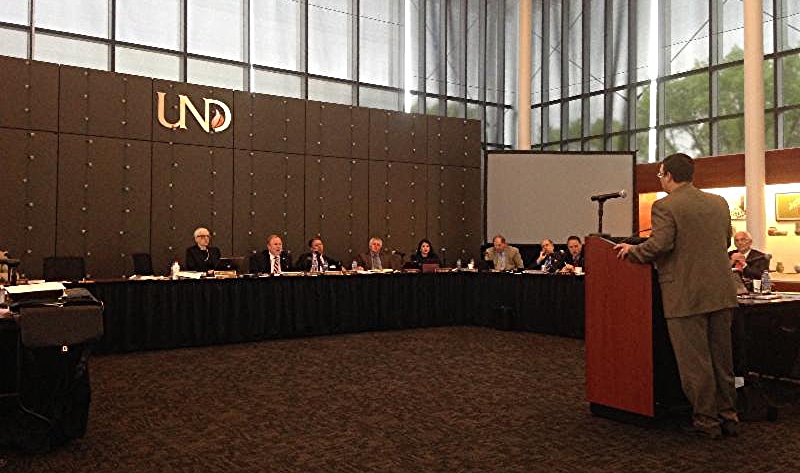 | |
Ben Schafer, Superintendent of Ray Public School District, addresses the Education Funding Committee on Monday. Schafer shared the perspective of a western ND school district faced with a large number of transitory students. In the last year, he said, his school district saw the addition of 90 new students and the outflux of 90 students. Ray PSD's student population during the last school district effectively remained at 270 students.
|
In its study, Picus Odden and Associates used the "Evidence-Based" (EB) model to recalibrate the foundation expenditure Per Student numbers enacted by the 2013 Legislature for the state's school finance formula, which were $8,810 for the 2013-14 school year and $9,092 for the 2014-15 school year. The EB model used also includes a strategy for improvement in order to facilitate a rise in student achievement. The model argues that resources to school districts are directly linked to student performance. Such resources include, according to Odden, elements like recruiting and supporting effective teachers and principals, classroom resources like books and professional development, additional helps for struggling students, and having teachers work in collaborative teams.
Overall, Odden said, "The structure (the state) has is nice, sleek, and the right structure to fit today's society." The study did, however, make several recommendations on how to "tweak" student weights for topics like ELL students, summer school, at-risk students, alternative schools, special education, early childhood special education, and data collection. The study recommends retaining the current system for small district adjustments, but urges policymakers to consider increasing the weights for districts with fewer than 125 students. Finally, the recalibrated foundation aid amounts of $8,810 and $9,092 that were established for the 2013-15 biennium were recommended to be, when recalibrated, $9,347 and $9,442. According to the Picus report, "The bulk of the increase is due to the change in the fringe benefit rates and, for 2014-15, includes the mandated 2-percentage point increase in district payments for pensions".
The Education Funding Committee will hold its next meeting on August 1. Between now and then, committee chair, Senator Tim Flakoll, will be working with Legislative Council to put together a bill draft that will utilize the Picus study and provide a platform to develop the 2015-17 biennium foundation aid funding formula.
Odden's presentation is available by clicking this link. The complete Picus Odden and Associates study, Recalibrating North Dakota's Per Student Number for the School Foundation Program", is also available through the link.
|
|
EPA Calls For CO2 Emission Reductions
|
|
|
|
EPA Emission Could Impact Electric Bills
- Mary Cate Mannion, KFYR-TV
The issue of cost has become a part of the debate on the EPA's Clean Air Act.
The draft proposal aims to cut carbon dioxide emissions from power plants by 30 percent by 2030, but both supporters and critics differ on how it will effect consumers electricity bills. While it's hard to project what retail electricity might cost, Basin Electric says that regulations, like the proposed rule, tend to pass a cost on to customers.
"It's 648 pages of complex info. Ultimately, we want to know what those rate impacts will be at the wholesale level, and how that will translate on the retail level. We do know that when you have additional regulations that does translate to consumers pockets," says Mary Miller, Basin Electric.
North Dakota will have two years to submit a compliance plan, and Basin Electric along with other power and coal industry companies have 120 days to submit comments to the EPA.
Click here for more information.
|
Power Plant Plan Further Clouds Coals Future
- Dina Cappiello and Adam Beam, Associated Press
President Barack Obama's ambitious plan to reduce the gases blamed for global warming from the nation's power plants gives many coal-dependent states more lenient restrictions and won't necessarily be the primary reason coal-fired power plants will be retired.
If Kentucky, for example, meets the new limits that the Obama administration proposed Monday, it would be allowed to release more heat-trapping carbon dioxide per unit of power in 2030 than plants in 34 states do now.
That's because the Environmental Protection Agency would only require Kentucky, which relies on coal for about 90 percent of its electricity needs, to improve its carbon dioxide emissions rate by 18 percent over the next 15 years. By 2030, Kentucky would be second only to North Dakota for having the most carbon-intensive power plants in the country.
Click here for the full story.
|
How Much Each State Has to Cut Carbon Emissions Under New EPA Regulations
- Chris Kardish and Kevin Tidmarsh, Governing Magazine
When the EPA announced it will require states to reduce emissions of carbon dioxide to 30 percent below 2005 levels by 2030, it wasn't applying that exact target to everyone. In practice, some states will have to lower emissions by more than 30 percent while others will cut below that, but the overall reduction would basically amount to the EPA reduction (see map here). That's because the agency set up a formula that looks at states' most recent emissions along with other factors such as their ability to shift to natural gas or expected closings of coal plants when setting a 2030 goal. The agency started with a baseline of 2012 emissions and applied some key assumptions about what each state could reasonably achieve by 2030. The EPA took that 2012 data, assumed basic increases in efficiency, accounted for unused capacity in the less-harmful natural gas sector, estimated how much a state could generate from renewable or nuclear sources and, lastly, forecasted how much a state could decrease demand from users.
For the full story, click here.
|
|
|
Lignite Research Council Approves Projects for Funding
|
Three research studies were approved for funding by the Lignite Research Council (LRC) in its June 5 meeting in Bismarck. The first request, for $50,000 of a total project cost of $1.15 million, was submitted by ClearSign Combustion Corporation. ClearSign has developed a technology (ECC) that can manipulate the flame used in coal combustion using high-voltage electric fields. This technology is anticipated to prevent pollution in the first place. The study will essentially look at how manipulation of flame geometry can reduce emissions like NOx, CO and CO2, and particulate matter and has the potential to make those reductions inexpensively.
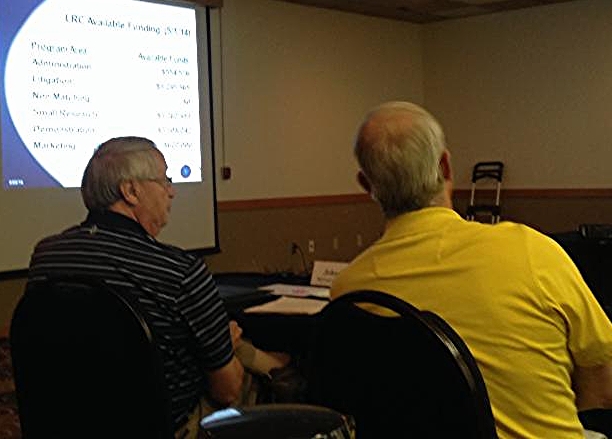 | |
Lignite Research Council members John Phillips, Coal Conversion Counties (CCC) representative, and Bob Fagerstrom, Dakota Gasification Company, listen as Lignite Energy Council VP of Research and Development Mike Jones gives an update on lignite research currently underway. Phillips also serves as a CCC representative on the NDAOGPC Executive Committee.
|
Another study approved for $50,000 in LRC funding was submitted by Envergex LLC and focused on "Enhanced High Capacity Sorbent and Process for CO2 Capture Using Hybrid Sorption (E-CACHYS™)". The E-CACHYS™ process uses solid sorbents to affect capture of CO2 from flue gas streams. The approved project will scale up methods for producing the E-CACHYS™ sorbents to maximize the CO2 loading capacity. The project will also strive to demonstrate the effectiveness of an enhanced process configuration in reducing sorbent attrition, accommodating operation with a finer particle size distribution, and incorporating a method to increase sorbent life. Outcomes of this project could mean identifying a means of increased sorbent capacity, thus lowering cycle rates and reducing the amounts of capital and operating costs.
Finally, a study submitted by the EERC was approved. This study dealt with a "multielement sorbent trap" (MEST) sampling method that's been developed by the EERC. This sampling method can be utilized for trace metal and halogen sampling. The purpose of the project is simply to validate the MEST sampling method in the eyes of the EPA. If the sampling method is validated by the EPA, the MEST method could potentially be used in lieu of Method 26A (the currently approved method), resulting in a cost savings of approximately $50,000 per year.
The recommendations of the LRC will be forwarded on to the ND Industrial Commission for final approval.
|
|
Vision West ND Update
|
Vision West ND Team members Shirley Brentrup and Vicky Steiner traveled to Stark, Golden Valley, Billings, and Slope counties last Tuesday as part of the HUD grant requirements to share the Vision WestND Regional Plan. The summary of the Regional Plan is available online at www.visionwestnd.com/documents/VWNDRegionalPlanSummary-FINAL.pdf.
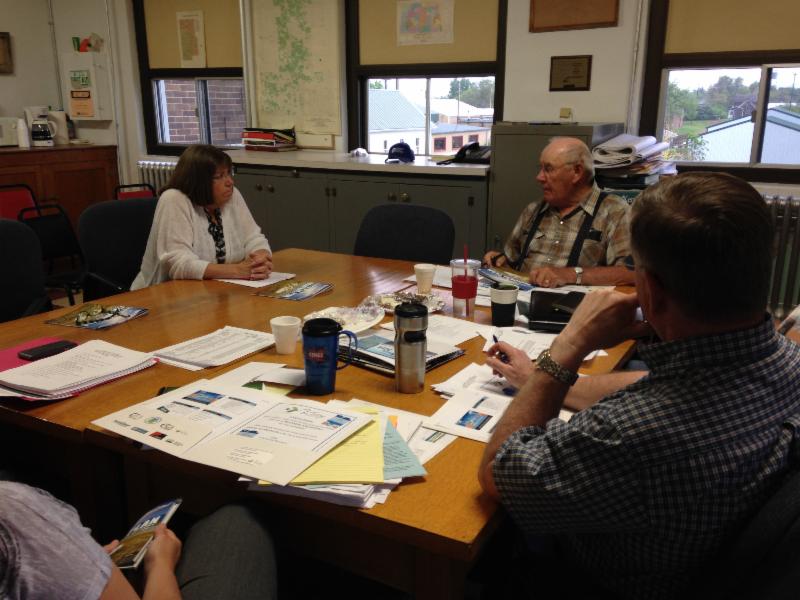 | |
Members of the Golden Valley County Commission listen as Shirley Brentrup, Vision West ND Program Director, explains the Vision West ND Regional Plan.
|
Commissioners asked questions about how funding will match the priorities in the regional plan. Slope County commissioners were curious about a new section road needed for an oil well site and if the township could require the oil company to provide the new road's upkeep. The township didn't want to add it to their system. The commissioners planned to visit with NDDOT staff on the laws of section line roads.
Executive Director Vicky Steiner said that the NDAOGPC Executive Committee is providing funds for the Vision West ND consortium to continue meeting after the grant ends in January 2015.
For more information on the Vision West ND project, please visit www.visionwestnd.com. You can "Like" Vision West ND on Facebook by going to www.facebook.com/pages/Vision-West-ND/281965481972432 or follow on Twitter by visiting twitter.com/VisionWestND.
|
|
NDAOGPC Continues to Accept Applications for 2014 Scholarship Awards
|
ATTENTION ND STUDENTS!!
A reminder that t he NDAOGPC is again sponsoring a scholarship program for students in North Dakota focusing on energy-related degrees. Students who have completed 12 credit hours or more are welcome to apply for one of six scholarships that will be awarded in August 2014. Applicants should be pursuing degrees in engineering, chemistry, geology, petroleum sciences or other studies directly related to the oil and gas industry. Invitations to apply for the Association's 2014 scholarships were recently sent to all North Dakota colleges, universities, and vocational schools. We strongly encourage all readers to share this opportunity with anyone they believe may qualify. The application can be downloaded HERE . he NDAOGPC is again sponsoring a scholarship program for students in North Dakota focusing on energy-related degrees. Students who have completed 12 credit hours or more are welcome to apply for one of six scholarships that will be awarded in August 2014. Applicants should be pursuing degrees in engineering, chemistry, geology, petroleum sciences or other studies directly related to the oil and gas industry. Invitations to apply for the Association's 2014 scholarships were recently sent to all North Dakota colleges, universities, and vocational schools. We strongly encourage all readers to share this opportunity with anyone they believe may qualify. The application can be downloaded HERE .
Last year, the Association awarded a total of $10,000 to six deserving students. Don't miss this great opportunity to gain financial assistance for an industry related education! The deadline for application submission is June 15, 2014.
|
|
Upcoming Events
|
|
June 12, 2014

You don't need to be a rocket scientist to know that the better a gravel road is made...
the less it costs to maintain.
Join Ken Skorseth, SD LTAP and Gravel Guru, on Thursday, June 12, 2014 for a FREE live and on-demand webinar exploring gravel road construction best practices straight from the field (via video) including how to: assess your gravel road conditions, prepare the road, apply stabilizer, and roll and finish your unpaved roads.
Travel with us to the site (without leaving your office) as Ken walks us through four live, in-field videos demonstrating real-time the best practices from the field. We'll cover the best practices in how to properly assess your site's conditions, prepare the road, apply the stabilizer, and roll and finish your unpaved roads. Then, after our virtual tour, grill Ken with your questions during our live Q&A session.
Learning Objectives
Attendees can expect the discussion and education of the following learning objectives:
- Road Design: Understanding of construction to reshaping including
shape and drainage, aggregate considerations, and alternatives - Road Maintenance: Understanding of grading to material
replacement - Road Stabilization: Understanding of the process involved, the
products required, and the benefits you can expect - Program Efficiency: Understanding of cost vs. savings, air quality
and safety, and potential sources of funding
The free webinar will begin at 1:00pm CDT and is expect to last 1-1.5 hours. Click here to register!
Gravel Roads Academy, sponsored by DustGard® Road Stabilizer, offers information and training on how to better maintain your gravel roads for superior stabilization, greater cost savings, and better air quality.
Learn more Gravel Roads Academy Website
June 25, 2014 
|
|
September 18, 2014
Be sure to mark your calendars for the 2014 Annual Meeting of the ND Association of Oil and Gas Producing Counties to be held Thursday, September 18, 2014 at the Grand Williston Hotel in Williston, ND. Information on hotel room blocks, the registration process, and sponsorship opportunities will be shared as we get closer to the event.
|
|
Please take your time to review all materials and links provided for your convenience. We at the ND Association of Oil and Gas Producing Counties will continue to provide you up-to-date information on upcoming events and news happening in North Dakota's oil and gas producing counties! Sincerely, Vicky Steiner
Executive Director
Brady Pelton
Deputy Executive Director
ND Association of Oil & Gas Producing Counties |
400 East Broadway Avenue Suite 304 Bismarck, ND 58501
|
|
|
|
|
Copyright © 2013. All Rights Reserved.
|
|
|
|